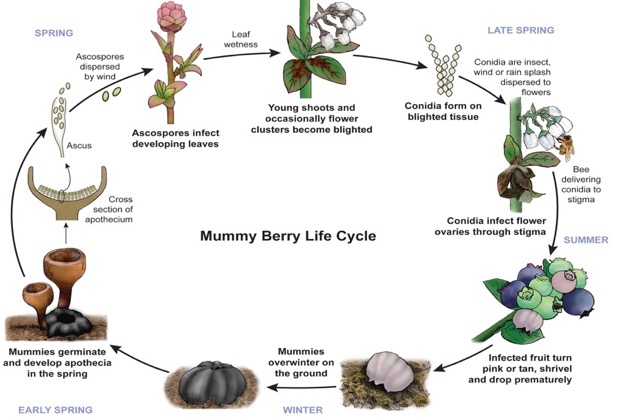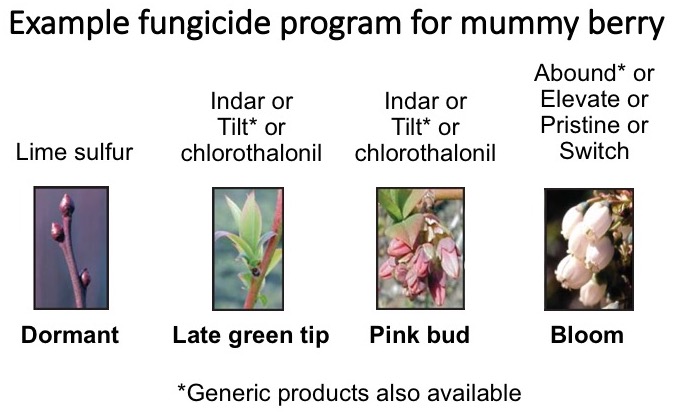The rise of the mummy: Mummy berries in Michigan
Mummy berry of blueberries has been found throughout Michigan and management strategies should be implemented to protect shoots.

Warmer temperatures over the last week have pushed mummy berries to germinate apothecia. Throughout Michigan, we are between early and late green tip and shoots are very susceptible to new mummy berry infections at this time. To date, germinated mummy berries with apothecia have been found in Ottawa and Saginaw counties and they are likely present throughout southwest Michigan currently (Fig. 1).
Background on the disease
Mummy berry, while less common over the past few years, is a very serious disease of highbush blueberries in Michigan and typically 2-4 fungicide applications are devoted to controlling it every year. The causal fungus Monilinia vaccinii-corymbosi can kill young vegetative shoots, reducing next year’s yield potential. In addition, infected berries are not edible and there is a zero tolerance for mummified berries in harvested fruit. Mummified berries fall off the bush and overwinter on the ground. They germinate in spring to form apothecia.
Previous research has shown that the optimum temperature for formation of apothecia and infection is 50 to 57 degrees Fahrenheit (10 to 14 degrees Celsius). Extended wet periods and frost promote infection. Furthermore, the presence of succulent green leaf tissue is also a basic requirement for primary infection, resulting in mummy berry shoot strikes. See the life cycle in Figure 2 for more information about the disease.

Control methods for mummy berry
Several cultural and chemical options are available to control mummy berry, including:
- Raking or cultivating to destroy mummies in spring.
- Covering mummies with soil or layer of mulch (2 inches thick) before bud break.
- Fungicide applications like Indar, Tilt, chlorothalonil or Pristine (see Fig. 3 for example fungicide program).
- Directing spray of lime sulfur (e.g., Sulforix) or urea to destroy apothecia.

If you choose this last option to burn down mummy berry apothecia, there are a few tips to consider in order to effectively clean your sprayer following the application (see below). Also, when developing a management program, recent research at Michigan State University and University of California has focused on the possible detrimental effects of FRAC 3 fungicides to pollinators, therefore it is recommended to utilize FRAC 3 fungicides in the earlier part of a management program (e.g., green tip) and keep mummy berry inoculum low, then switch away from FRAC 3 fungicides as we approach bloom to other fungicide classes (e.g., FRAC codes 7, 11 or 17).
Cleaning your sprayer following a sulfur or dormant spray application
- Rinse immediately after use.
- Utilize a neutralizer and cleaner during the cleaning (typically use 1-pound powder detergent per 100 gallons).
- Remove screens, strainers and gaskets during the cleaning.
- After the cleaner has been added, agitate, flush or rinse.
- For larger tanks, consider using a rotating tank rinse nozzle setup to get good coverage inside your sprayer tank
Refer to pesticide labels for other specific cleaning instructions depending on the pesticide utilized. Always flush with clean water and drain even if you plan to apply the same material the next day. Remember, stainless steel nozzles tend to last significantly longer than aluminum, brass or plastic nozzles.



 Print
Print Email
Email